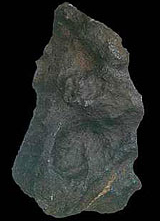Identifying meteorites
Depending on the type of meteorite, and how long it has been on Earth, it can sometimes be very difficult to tell meteorites apart from terrestrial rock and some man-made materials. But there are some tell-tale signs left by a meteorite's long journey to Earth that reveal its true identity. So when searching for a meteorite, what should you look for?

Iron meteorite showing dark fusion crust.
A dark crust
The rapid deceleration a meteorite experiences as it travels into the Earth's atmosphere causes an intense heat. This heat melts the surface of the meteorite, forming a thin layer known as the fusion crust.
The fusion crust is usually black or dark grey and generally no more than a millimetre thick. Small gas bubbles and 'dribbles' from the air resistance can also sometimes be seen.
The fusion crust makes recent and unweathered meteorites easy to identify.
Internal features
Where the fusion crust has been worn away, internal features become more important.
The most common type of meteorite found in temperate places like the UK are iron meteorites, because they stand out as different from our regular rocks. They are also strongly magnetic and very dense. It is difficult, however, to distinguish industrial iron from iron meteorites without chemical analysis.
The most common type of stony meteorites, chondrites, can be identified by millimetre-sized spherical objects contained within a finer grained material. These fine grain 'chondrules' often contain metal and can be magnetic. But there are many terrestrial rocks that resemble stony meteorites, and again chemical analysis may be needed.

Marcasite nodules like this one are often mistaken for meteorites.
Look-alikes
Perhaps the commonest objects mistaken for meteorites are spherical, rusty-looking marcasite nodules. Consisting of iron sulphide, marcasite is quite dense and has rounded protrusions that can give a melted appearance. However, it is less dense than iron meteorites and is commonly found in chalk.
Industrial slag also has a melted appearance and usually contains bubbles. So it is commonly mistaken for meteorites. But slag has melted all the way through, rather than having a very thin crust, and the gas bubbles it contains are often large.
Meteorite identification checklist
- Looks unusual and out of place.
- Thin fusion crust which is black or grey and may contain small bubbles.
- Regmaglypts - thumb-shaped imprints sculpted due to the rapid air flow as it falls through the atmosphere.
- Iron meteorites are dense and magnetic.
- Stony meteorites contain millimetre-sized spherical objects in a finer grain mix.
Toolbox

In World War II the Museum was used as a secret base to develop new gadgets for allied spies, including an exploding rat!